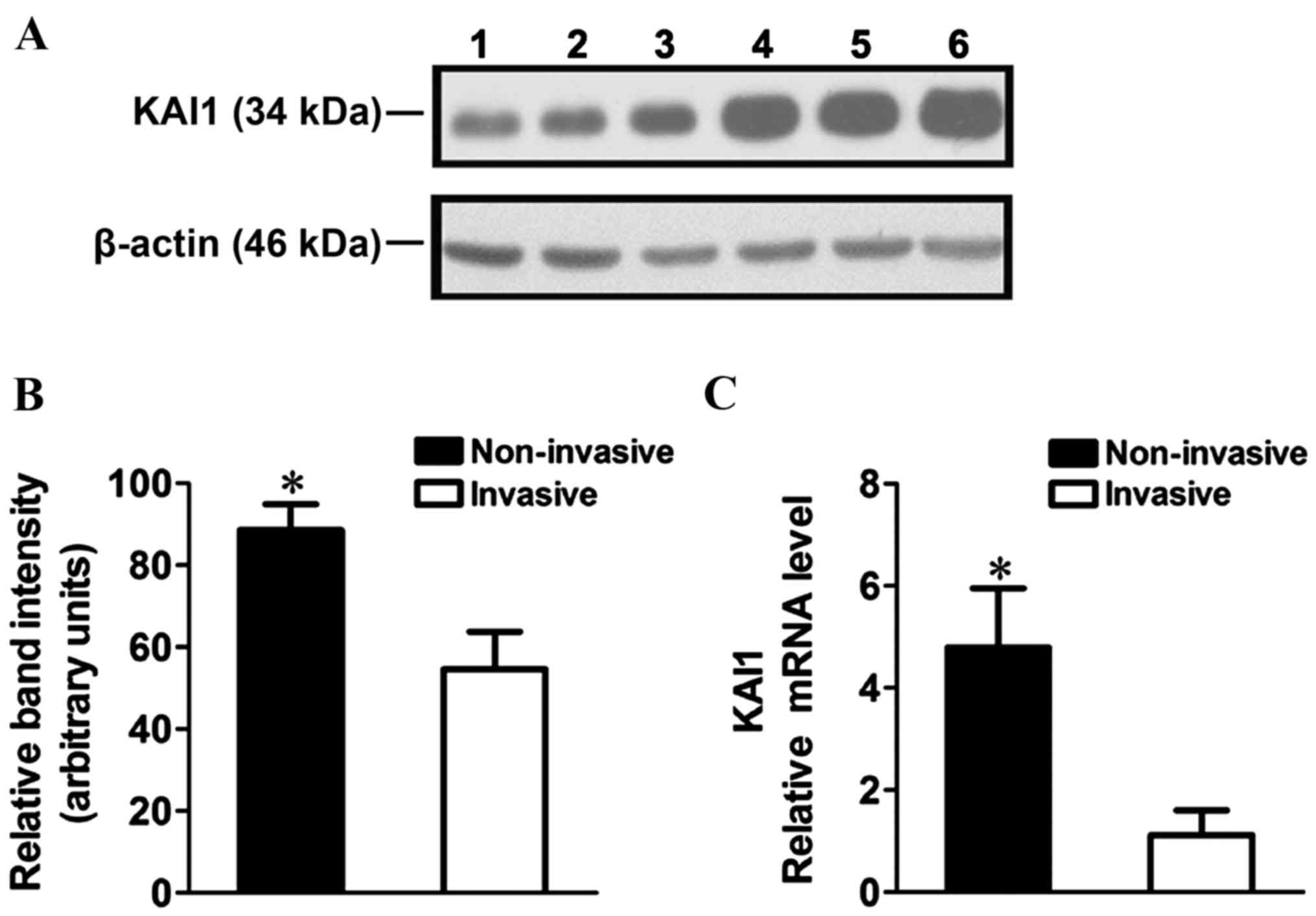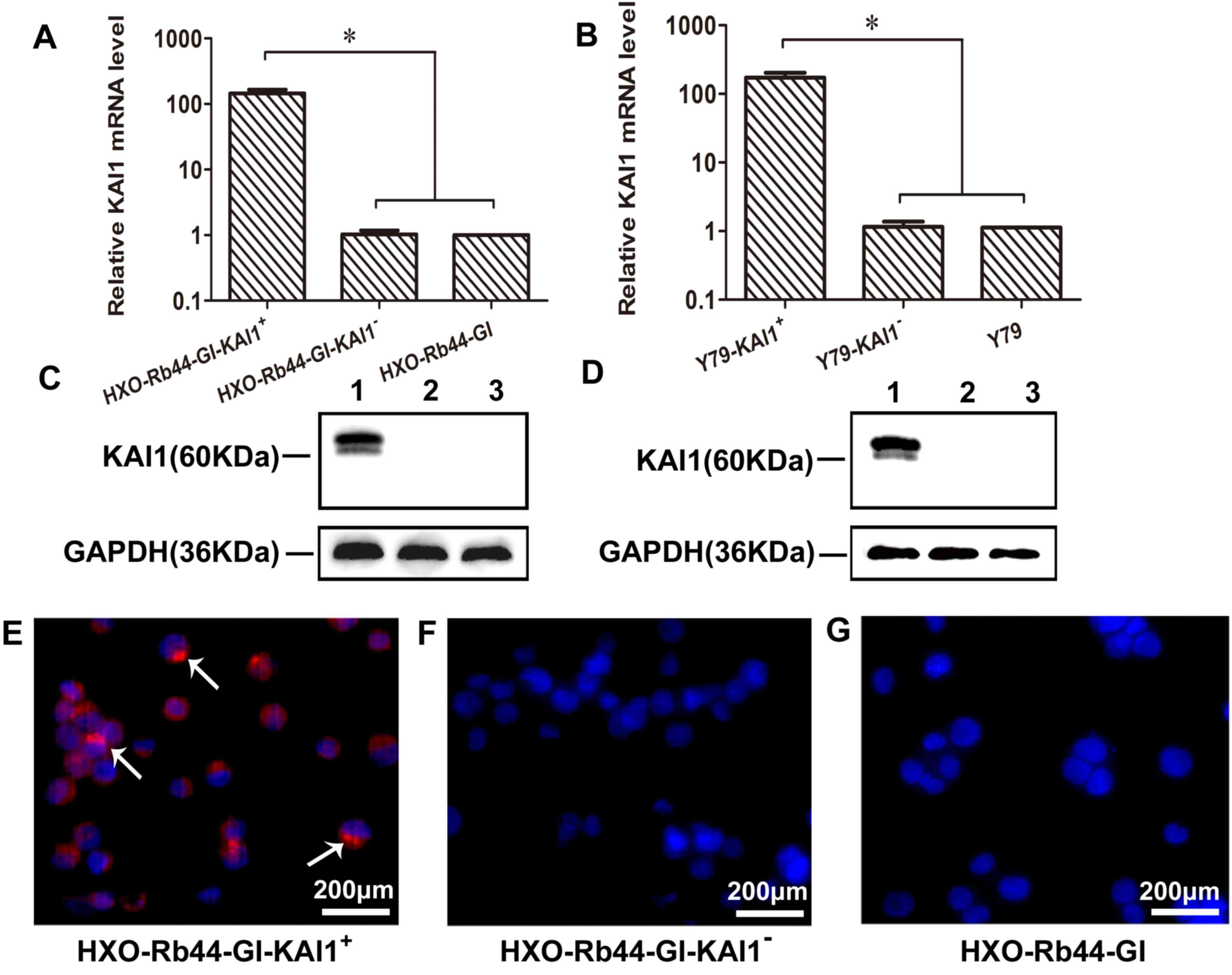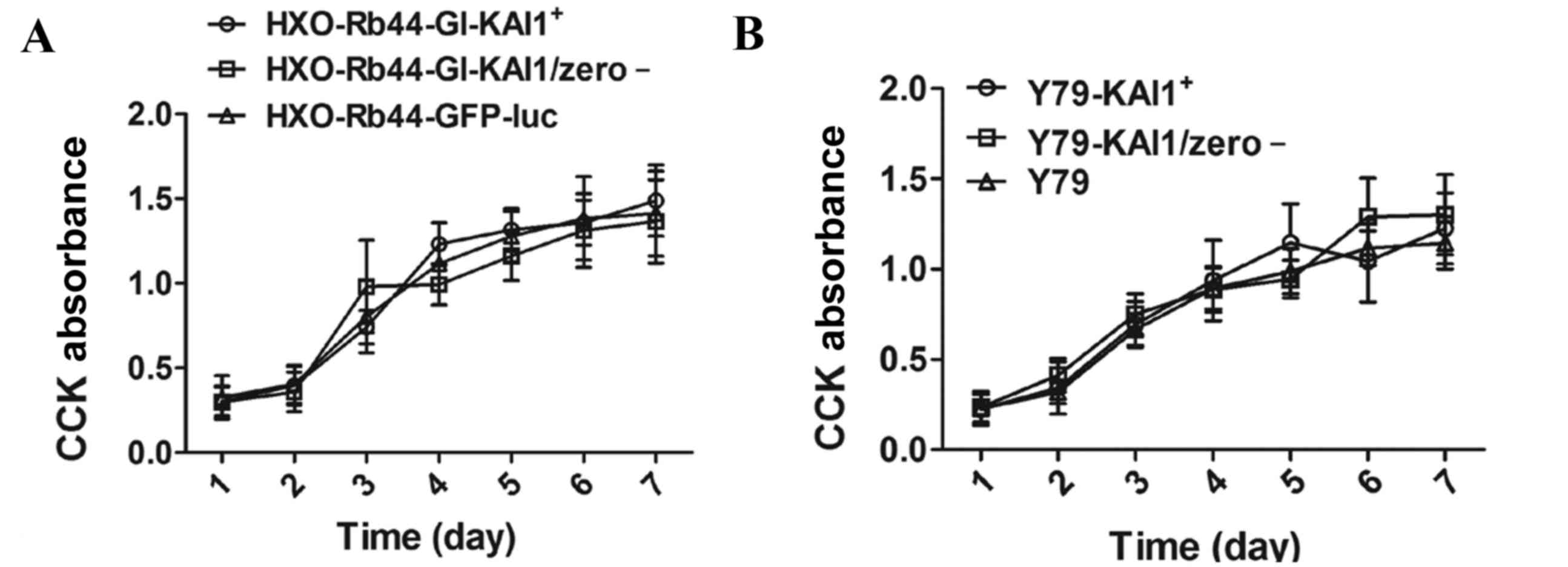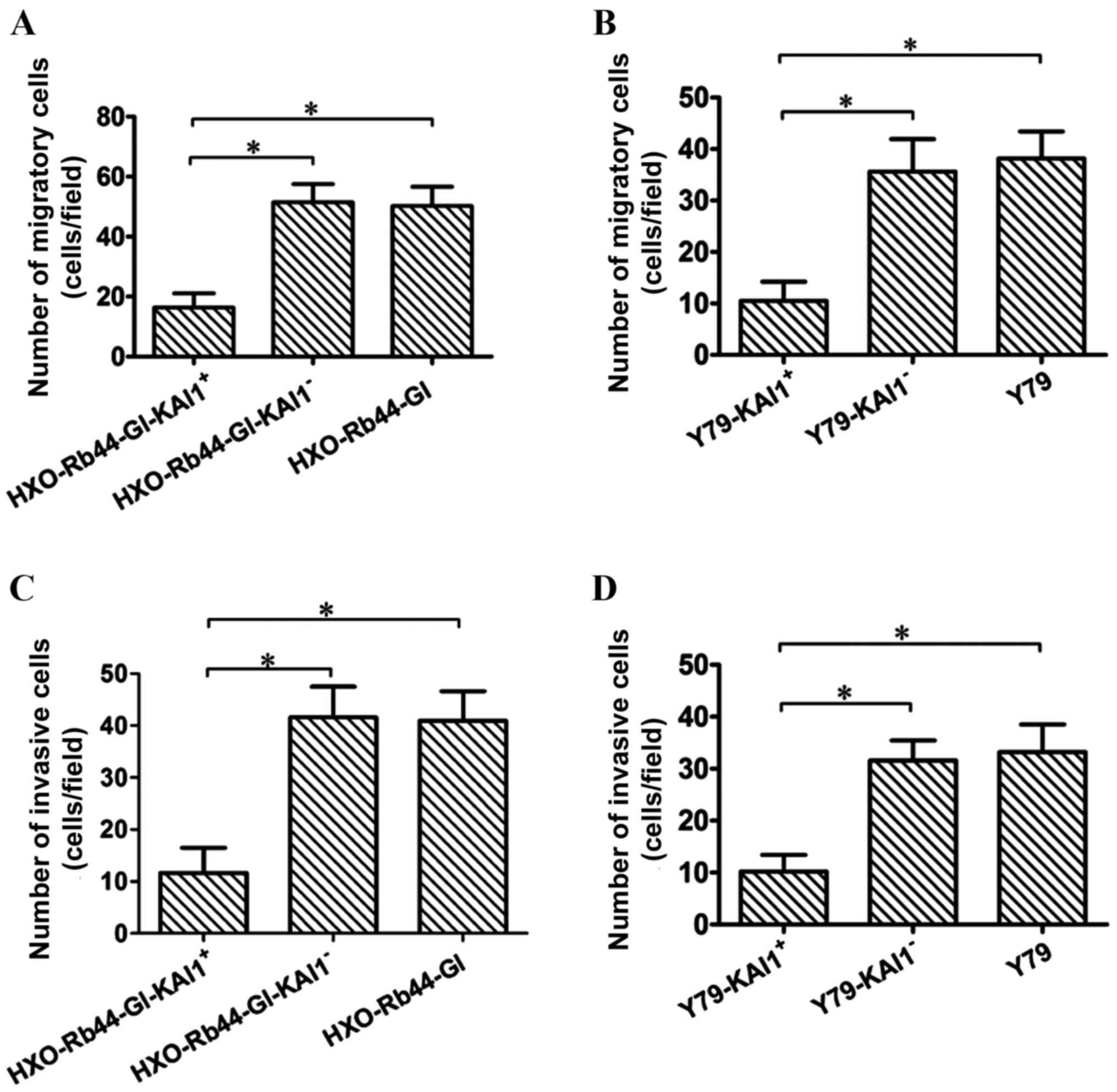Overexpression of KAI1 inhibits retinoblastoma metastasis in vitro
- Authors:
- Published online on: December 16, 2016 https://doi.org/10.3892/ol.2016.5507
- Pages: 827-833
Abstract
Introduction
Retinoblastoma (RB) is the most frequent retinal tumor worldwide and the most common primary intraocular malignancy in childhood, accounting for ~4% of all pediatric malignancies (1). The majority of patients with retinoblastoma are not diagnosed until the disease has reached an advanced stage or metastasis has occurred (2). Tumor cells are able to extend through the optic nerve, sclera and choroid to access the extraocular space, leading to life-threatening systemic metastasis (3,4). Metastatic RB has a high mortality rate due to a limited range of chemo- and radiotherapeutic treatments (5). Although intensive multimodal therapies, including high-dose chemotherapy with autologous hematopoietic stem cell rescue, are reported to be effective in the treatment of metastatic RB, it remains a life threatening disease (6).
Cluster of differentiation 82 (KAI1) was first identified in prostate cancer cells by Dong et al (7) and has a significant role in the inhibition of tumor metastasis. As a member of the transmembrane 4 superfamily, KAI1 contains four hydrophobic transmembrane domains and a large extracellular N-glycosylated structure, which interacts with integrin, epidermal growth factor receptor and other tetraspanins (8–10). KAI1 interactions are associated with cell-cell and cell-extracellular matrix interactions, as well as cell signaling and motility. Therefore, KAI1 may affect the invasion and metastasis of tumor cells (11). Decreased KAI1 expression is correlated with the development of tumor metastasis and poor prognosis in a wide variety of human malignancies, including prostate (12), breast (13), pancreatic (14) and lung cancer (15). Decreased expression of KAI1 was reported in metastatic human RB samples (16). However, the biological effect of KAI1 on RB cells remains unclear.
In the present study, KAI1 expression was analyzed in 26 human retinoblastoma samples, representing non-invasive and invasive stages. In addition, the in vitro effect of KAI1 on RB cell migration and invasion was studied in two RB cell lines.
Materials and methods
Ethics statement
The present study conformed to the Declaration of Helsinki and was approved by the Ethical Committee of the Xinhua Hospital Affiliated to Shanghai Jiaotong University School of Medicine (Shanghai, China). Written consent was obtained from the patients participating in the study.
Tissue samples
Samples were obtained from RB patients at Xinhua Hospital (Shanghai, China) between May 2010 and February 2013, who received no treatment during the enucleation procedure. In total, 14 eyes presenting with no RB invasion of the optic nerve or choroid were selected, representing the non-invasive group, and 12 eyes presenting with invasion of the optic nerve or choroid were taken, representing the invasive group.
Detection of KAI1 protein using western blot analysis
Tumor samples were ground into powder in liquid nitrogen. Total protein was extracted using an ice-cold SDS cell-lysis buffer (BiYunTian, P0013G, Shanghai, China), containing protease inhibitors, and lysate was centrifuged (15,800 × g for 30 min at 4°C) to remove debris. After quantitative analysis, all the protein samples were mixed with the loading buffer and then boiled with the burning water for 5 min. The protein samples were separated on a 10% SDS-PAGE gel and transferred onto a polyvinylidene difluoride membrane (GE Healthcare Life Sciences, Chalfont, UK). The membrane was blocked in TBS and Tween® 20 with 5% skimmed milk for 90 min, followed by incubation with monoclonal mouse anti-KAI1 antibody (1:500, sc-4486 Santa Cruz Biotechnology, Inc., Dallas, TX, USA) at 4°C overnight. Following three cycles of washing with TBST, the membrane was incubated with horseradish peroxidase-conjugated goat anti-mouse immunoglobulin G (1:1,000, Jackson, 115-035-206, USA) at room temperature for 1 h. β-actin (1:2,000, Proteintech, 6008-1-Ig, USA) was used as an endogenous control. The resulting signals were measured using an enhanced chemiluminescence system. Band intensity was normalized to the value of β-actin (Image J, NIH, USA). All experiments were performed in triplicate.
Western blot analysis for protein samples in RB cells. RB cells incubated in mediums were collected and transferred into EP tube with the number of 1×106 in each tube. After centrifuging (4°C, 800 rpm, 10 min), each EP tube were added with an ice-cold SDS cell-lysis buffer (BiYunTian, P0013G, Shanghai, China), containing protease inhibitors, and lysate and were centrifuged (15,800 × g for 30 min at 4°C) to remove debris. The following steps and experimental conditions were in consistent with the western blot analysis for tumor samples.
Measuring KAI1 gene expression using the reverse transcription-quantitative polymerase chain reaction (RT-qPCR)
RB tissues were ground into powder in liquid nitrogen and dissolved using a Trizol® reagent kit (Invitrogen; Thermo Fisher Scientific, Inc., Waltham, MA, USA). The MyiQ and iQ5 Real-Time PCR Detection system (Bio-Rad Laboratories, Inc., Hercules, CA, USA), SYBR-Green kit and SYBRR Premix Ex Taq™ kit (Takara Bio, Inc., Otsu, Japan) were used to perform RT-qPCR and subsequently measure KAI1 mRNA expression. The primer pairs for KAI1 and GAPDH were as follows: KAI1 forward, 5′-TGTCCTGCAAACCTCCTCCA-3′ and reverse, 5′-CCATGAGCATAGTGACTGCCC-3′; and GAPDH forward, 5′-CCATGGCACCGTCAAGGCTGA-3′ and reverse, 5′-GGGCCATCCACAGTCTTCTGG-3′. Reaction parameters for RT-qPCR were as follows: 94°C for 5 min followed by 40 cycles of 94°C for 30 sec, 55°C for 30 sec and 72°C for 30 sec. Each reaction was performed in duplicate. The relative mRNA levels of KAI1 and GAPDH were calculated using the 2−ΔΔCq method (17).
Cell lines and culture conditions
HXO-Rb44-Gl is a green fluorescent protein (GFP) and luciferase expressing HXO-Rb44 human RB cell line (18). The HXO-Rb44 cell line was originally established by the Department of Ophthalmology, Hunan Medical University, Xiangya Hospital, Changsha, China (19). The Y79 human RB cell was purchased from the American Type Culture Collection (Manassas, VA, USA). Non-adherent cell lines were cultured in RPMI-1640 supplemented with 10% fetal bovine serum (FBS) (both Gibco; Thermo Fisher Scientific, Inc.) at 37°C in 5% CO2 humidified air.
Construction of recombinant lentivirus expressing KAI1
pCMV-KAI1 was provided by Dr Dong of the National Institute of Health (Bethesda, MD, USA). The 753 bp KAI1 and the 849 bp enhanced GFP (EGFP) cDNA fragments were amplified from pCMV-KAI1 and pEGFP-N1 respectively using RT-PCR with the following primers: KAI1 forward, ATTCGCCTAGGACTAGTGATCAGCCACCATGGGCTCAGCCTGTATCAA and reverse, CGGGGTACTTGGGGACCTTGCTGT; EGFP forward, CAAGGTCCCCAAGTACCCCGGGGGTGGCGGAGGGTCTAGAATGGTGAGCAAGGGCGAG and reverse, TCGGCGGCCGCTTATTTGTCGTCATCATCCTTATA. The two fragments were fused together to form a 1585 bp KAI1-EGFP DNA fragment using PCR, and inserted into the puromycin-resistant lentiviral vector pMB-Puro (Neuronbiotech Co., Ltd., Shanghai, China), replacing the firefly luciferase gene. The recombinant plasmid pMB-Puro-KAI1-EGFP and the two 2nd generation packaging plasmids, psPAX2 and pMD2.G (Addgene, Inc., Cambridge, MA, USA), were introduced into 293T cells (donated by American type culture collection), and the resulting virus (Lenti-MPKG) was harvested and titrated. Briefly, 5×104/well 293T cells were plated onto 6 well plate 1 day before infection. Subsequently, these cells were 10-fold serial dilutied. 3 days after infection, these cells were digested by EDTA solution and centrifuged. The titer of virus was determined by real-time qPCR (20,21). A control virus containing EGFP alone (Lenti-MPG) was generated in parallel.
Generation of stable Rb-KAI1 cells
HXO-Rb44-Gl cells and Y79 cells were infected with Lenti-MPKG to generate stable HXO-Rb44-Gl-KAI1+ and Y79-KAI1+ cells, respectively. The stable Rb-KAI1 cells were selected using 4 µg/ml puromycin. HXO-Rb44-Gl and Y79 cells were infected with Lenti-MPG to generate the stable control cell lines, HXO-Rb44-Gl-KAI1− and Y79-KAI1−. Stable transduced cells were maintained in RPMI-1640 medium containing 10% FBS and 2 µg/ml puromycin.
Immunofluorescence staining analysis
Cultured cells were collected by centrifugation (15,800 × g for 15 min at 4°C), washed with cold PBS and fixed in 4% paraformaldehyde. Fixed cells were subsequently blocked with PBS containing 3% bovine serum albumin (BiYunTian, ST023, Shanghai, China) for 1 h, and incubated with monoclonal mouse anti-KAI1 antibody (1:100) overnight at 4°C. Cells were washed with PBS and centrifuged (3,600 × g for 15 min at 4°C) prior to incubation with rhodamine-tagged secondary antibody (BiYunTian, A-0568, Shanghai, China) at 37°C for 1 h. Tagged cells were subsequently mounted with DAPI-containing mounting solution and observed using a fluorescence microscope.
Cell proliferation analysis
The Cell Counting Kit-8 (CCK-8) assay (Dojindo Molecular Technologies, Inc., Kumamoto, Japan) was used to quantify cell growth. Cells (HXO-Rb44-GI-KAI1+, HXO-Rb44-Gl-KAI1−, HXO-Rb44-Gl; Y79-KAI1+, Y79-KAI1−, Y79) were seeded into 96-well plates at a density of 1×104 cells per well in 100 µl RPMI-1640 10% FBS. At the indicated time points (1 day, 2 day, 3 day, 4 day, 5 day, 6 day, 7 day), 10 µl CCK-8 was added to each well and the plate was incubated for 1 h at 37°C. The optical absorption of each well at 450 nm was measured using a spectrophotometer.
Cell migration assay
The cell migration assay was performed using a Transwell® chamber and polyethylene terephthalate membrane (PET) insert (Corning Inc., Corning, NY, USA) with 8 µm pores. A total of 100 µl cells (0.5×106/ml) (HXO-Rb44-GI-KAI1+, HXO-Rb44-Gl-KAI1−, HXO-Rb44-Gl; Y79-KAI1+, Y79-KAI1−, Y79) and 200 µl serum free RPMI-1640 media were added to the top chamber. A total of 500 µl RPMI-1640 media with 10% FBS was added to the bottom chamber as a chemoattractant. Each cell line was plated in three duplicate wells. Following 24 h incubation (37°C, 5% CO2), the migratory cells in the bottom chambers were counted using a light microscope in five randomly selected visual fields.
Cell invasion assay
The cell invasion assay was performed using a modified Transwell chamber. PET inserts with 8 µm pores were pre-coated with 30 µl 20% Matrigel® (BD Biosciences, Franklin Lakes, NJ, USA) diluted in RPMI-1640 media. A total of 100 µl cells (1×106/ml) (HXO-Rb44-GI-KAI1+, HXO-Rb44-Gl-KAI1−, HXO-Rb44-Gl; Y79-KAI1+, Y79-KAI1−, Y79) and 200 µl serum free RPMI-1640 media were added to the top chamber. A total of 500 µl RPMI 1640 media with 10% FBS was added to the bottom chamber. Each cell line was plated in three duplicate wells. Following 48 h incubation (37°C, 5%CO2), the invasive cells in the bottom chambers were counted using a light microscope in five randomly selected visual fields.
Statistical analysis
Values are presented as the mean ± standard deviation. Data was analyzed using the Student's t-test (Two groups comparisons), or one-way analysis of variance (ANOVA) test (multigroups comparisons) with post hoc contrasts by Student-Newman-Keuls test, and using Statistical Analysis Software (SAS 9.3 Institute, Cary, NC, USA). P<0.05 was considered to indicate a statistically significant difference.
Results
Changes in KAI1 expression in human RB tissues
KAI1 mRNA and protein expression in human RB tissue was analyzed using RT-qPCR and western blot analysis. A ~2-fold decrease in KAI1 protein expression (Fig. 1A and B; P=0.0061) and ~4-fold decrease in KAI1 mRNA expression was observed in the invasive cells compared with the non-invasive cells (Fig. 1C; P<0.0001).
KAI1 overexpression in transduced RB cell lines
Expression of KAI1 in transduced HXO-Rb44-Gl and Y79 cells was analyzed using RT-qPCR, western blotting and immunofluorescence staining (Fig. 2). A >100-fold increase in KAI1 mRNA expression was observed in the KAI1+ cell lines (Fig. 2A and B; P<0.0001). Positive KAI1 bands at 60 kDa were observed in the KAI1+ cell lines and not in the KAI1− or control cells (Fig. 2C and D). In addition, KAI1 protein expression was observed in the cell membrane and nucleus of HXO-Rb44-GI-KAI1+ cells using immunofluorescence staining but was not observed in the corresponding KAI− cells (Fig. 2E-G). These results are consistent with immunofluorescence staining patterns observed in previous studies (22).
Effect of KAI1 overexpression on cell growth
CCK-8 analysis was performed on HXO-Rb44-Gl cells and Y79 cells over 7 consecutive days. No significant difference in cell growth was observed between the KAI1 overexpressing and control cells (Fig. 3).
Effect of KAI1 on RB cell migration and invasion
The migration and invasion of transduced HXO-Rb44-Gl cells and Y79 cells was compared with control cells. The number of migratory cells in the HXO-Rb44-Gl-KAI1+ group was significantly decreased compared with the HXO-Rb44-Gl-KAI1− and HXO-Rb44-Gl groups (Fig. 4A; P<0.0001). Similarly, the number of migrated cells in the Y79-KAI1+ group was significantly decreased compared with the Y79-KAI1− and Y79 groups (Fig. 4B; P<0.0001).
A statistically significant reduction in the invasive ability of the cells was observed in the KAI1 and Y79 transduced cell lines compared with the respective control cell lines. The number of invasive cells was 11.65±4.85, 41.55±5.92 and 40.95±5.67 in the HXO-Rb44-Gl-KAI1+, HXO-Rb44-Gl-KAI1− and HXO-Rb44-Gl cell lines, respectively (Fig. 4C; P<0.0001). The number of invasive cells was 10.20±3.20, 31.55±3.89 and 33.20±5.32 in the Y79-KAI1+, Y79-KAI1− and Y79 cell lines, respectively (Fig. 4D; P<0.0001).
Discussion
Poor RB prognosis is primarily due to the occurrence of distant metastasis and organ infiltration (5). Developing novel methods of metastasis inhibition is an important aim of cancer research. The KAI1 gene is a known suppressor of tumor metastasis (23–25) and has been implicated in the regulation of cell adhesion, proliferation, motility, fusion, signaling and differentiation (26). To investigate the effect of KAI1 on RB migration and invasion, KAI1 expression in RB tissue was investigated in the present study. In addition, the effect of KAI1 overexpression on RB cell migration and invasion was examined.
KAI1 expression levels in RB tissues were evaluated, and KAI1 mRNA and protein were observed to be expressed at decreased levels in invasive RB tissue compared with non-invasive RB tissue. Consistent with the results of the present study, a previous report demonstrated a reduction in the expression of KAI1 protein in metastasized human RB samples (16). Similar results were reported in other types of tumor tissue, for example, increased KAI1 protein expression was observed in early stage colorectal cancer, but the expression level decreased as the cancer progressed into the later stages (27). Research on breast cancer demonstrated a 10-fold decrease in KAI1 mRNA expression in metastatic lesions compared with the primary tumors (28). Therefore, the reduction in KAI1 expression may be involved in the RB metastatic process.
The results of the present study demonstrated that overexpression of KAI1 in HXO-Rb44-Gl cells and Y79 cells did not have any significant effect on cell growth, which is consistent with observations made in breast and other types of cancer (29,30). Increased levels of migration and invasion are associated with cancer metastasis, and previous research using the Boyden chamber assay indicated that pancreatic cancer cells infected with KAI1 demonstrate a reduced invasive ability (30). Similar observations were reported in studies in hepatocellular carcinoma and breast cancer (29,31). Consistent with the literature, the results of the present study demonstrated that migration and invasion is significantly inhibited in HXO-Rb44-Gl-KAI1+ and Y79-KAI1+ cells compared with KAI1− RB cells, suggesting that KAI1 suppresses migration and invasion in RB.
However, the exact mechanism of KAI1-mediated cancer metastasis inhibition remains unclear. It has been reported that KAI1 may suppress tumor metastasis by linking to cell surface molecules, including tetraspanins, integrins, epidermal growth factor receptor and protein kinase C (32,33). Additionally, KAI1 has been demonstrated to stabilize E-cadherin and β-catenin complexes in malignant cells, inhibiting tumor metastasis (34). Epithelial-mesenchymal transition (EMT) increases levels of cell migration, causing epithelial cells to lose epithelial characteristics and gain a mesenchymal phenotype (35). Previously, KAI1 has been demonstrated to cause certain EMT-associated genetic changes, including upregulation of cadherin 1 and catenin-α 1, and downregulation of hepatocyte growth factor and fibronectin 1 (22). In addition, upregulation of matrix metalloproteinases, and downregulation of TIMP metalloproteinase inhibitor 1 and SRC proto-oncogene, non-receptor tyrosine kinase are implicated in the inhibition of KAI1 in metastatic tumors (22). Therefore, KAI1 may suppress metastasis by regulating EMT, and regulating the migratory and invasive abilities of RB cells, however further research into the molecular mechanisms of KAI1-mediated metastasis inhibition in RB is required.
In conclusion, KAI1 may serve an essential role in the regulation of malignant cell migration and invasion in RB. The results of the present study may aid in the development of novel treatments to prevent and regulate RB metastasis.
Acknowledgements
The authors thank all staff of the central laboratory of Xinhua Hospital (Shanghai, China), in particular Dr Rang Xu, for providing various experimental services. The authors thank Dr Dafeng Xu (Molecular Biology Department, East China University Of Science and Technology) for assistance with the production of the manuscript and Dr Hui Wang (Department of Orthopedics, Xinhua Hospital Affiliated to Shanghai Jiaotong University School of Medicine) for help with the data analysis.
References
|
Kiss S, Leiderman YI and Mukai S: Diagnosis, classification, and treatment of retinoblastoma. Int Ophthalmol Clin. 48:135–147. 2008. View Article : Google Scholar : PubMed/NCBI | |
|
Liu Q, Wang Y, Wang H, Liu Y, Liu T and Kunda PE: Tandem therapy for retinoblastoma: Immunotherapy and chemotherapy enhance cytotoxicity on retinoblastoma by increasing apoptosis. J Cancer Res Clin Oncol. 139:1357–1372. 2013. View Article : Google Scholar : PubMed/NCBI | |
|
Shields CL and Shields JA: Basic understanding of current classification and management of retinoblastoma. Curr Opin Ophthalmol. 17:228–234. 2006. View Article : Google Scholar : PubMed/NCBI | |
|
de Moura LR, Marshall JC, Di Cesare S, Fernandes BF, Antecka E and Burnier MN: The effect of imatinib mesylate on the proliferation, invasive ability, and radiosensitivity of retinoblastoma cell lines. Eye (Lond). 27:92–99. 2013. View Article : Google Scholar : PubMed/NCBI | |
|
Chawla B, Hasan F, Azad R, Seth R, Upadhyay AD, Pathy S and Pandey RM: Clinical presentation and survival of retinoblastoma in Indian children. Br J Ophthalmol. 100:172–178. 2016. View Article : Google Scholar : PubMed/NCBI | |
|
Dunkel IJ, Khakoo Y, Kernan NA, Gershon T, Gilheeney S, Lyden DC, Wolden SL, Orjuela M, Gardner SL and Abramson DH: Intensive multimodality therapy for patients with stage 4a metastatic retinoblastoma. Pediatr Blood Cancer. 55:55–59. 2010.PubMed/NCBI | |
|
Dong JT, Lamb PW, RinkerSchaeffer CW, Vukanovic J, Ichikawa T, Isaacs JT and Barrett JC: KAI1, a metastasis suppressor gene for prostate cancer on human chromosome 11p11.2. Science. 268:884–886. 1995. View Article : Google Scholar : PubMed/NCBI | |
|
Park JJ, Jin YB, Lee YJ, Lee JS, Lee YS, Ko YG and Lee M: KAI1 suppresses HIF-1α and VEGF expression by blocking CDCP1-enhanced Src activation in prostate cancer. BMC Cancer. 12:812012. View Article : Google Scholar : PubMed/NCBI | |
|
Lee HA, Park I, Byun HJ, Jeoung D, Kim YM and Lee H: Metastasis suppressor KAI1/CD82 attenuates the matrix adhesion of human prostate cancer cells by suppressing fibronectin expression and β1 integrin activation. Cell Physiol Biochem. 27:575–586. 2011. View Article : Google Scholar : PubMed/NCBI | |
|
Gellersen B, Wolf A, Kruse M, Schwenke M and Bamberger AM: Human endometrial stromal cell-trophoblast interactions: Mutual stimulation of chemotactic migration and promigratory roles of cell surface molecules CD82 and CEACAM1. Biol Reprod. 88:802013. View Article : Google Scholar : PubMed/NCBI | |
|
Feng J, Huang C, Wren JD, Wang DW, Yan J, Zhang J, Sun Y, Han X and Zhang XA: Tetraspanin CD82: A suppressor of solid tumors and a modulator of membrane heterogeneity. Cancer Metastasis Rev. 34:619–633. 2015. View Article : Google Scholar : PubMed/NCBI | |
|
Bouras T and Frauman AG: Expression of the prostate cancer metastasis suppressor gene KAI1 in primary prostate cancers: A biphasic relationship with tumour grade. J Pathol. 188:382–388. 1999. View Article : Google Scholar : PubMed/NCBI | |
|
Mooez S, Malik FA, Kayani MA, Rashid R, Zahid A and Khan A: Expressional alterations and transcript isoforms of metastasis suppressor genes (KAI1 and KiSS1) in breast cancer patients. Asian Pac J Cancer Prev. 12:2785–2791. 2011.PubMed/NCBI | |
|
Friess H, Guo XZ, BeRBerat P, Graber HU, Zimmermann A, Korc M and Büchler MW: Reduced KAI1 expression in pancreatic cancer is associated with lymph node and distant metastases. Int J Cancer. 79:349–355. 1998. View Article : Google Scholar : PubMed/NCBI | |
|
Shiwu WU, Lan Y, Wenqing S, Lei Z and Yisheng T: Expression and clinical significance of CD82/KAI1 and E-cadherin in non-small cell lung cancer. Arch Iran Med. 15:707–712. 2012.PubMed/NCBI | |
|
Lakshmi S Amirtha, Pushparaj V, Krishnamurthy V, Biswas J, Krishnakumar S and Shanmugam MP: Tetraspanin protein KAI1 expression in retinoblastoma. Br J Ophthalmol. 88:593–595. 2004. View Article : Google Scholar : PubMed/NCBI | |
|
Livak KJ and Schmittgen TD: Analysis of relative gene expression data using real-time quantitative PCR and the 2(−Delta Delta C (T)) Method. Methods. 25:402–408. 2001. View Article : Google Scholar : PubMed/NCBI | |
|
Ji X, Zhang J, Cheng L, Wei F, Li H, Liu X, Chen X, Li C, Wang Y and Huang Q: Oncolytic adenovirus delivering herpes simplex virus thymidine kinase suicide gene reduces the growth of human retinoblastoma in an in vivo mouse model. Exp Eye Res. 89:193–199. 2009. View Article : Google Scholar : PubMed/NCBI | |
|
Xu H, Wang C, Zhu H, Liu S, Xu X and Jiang Y: Characteristics of an established retinoblastoma cell line HXO-Rb44. Yan Ke Xue Bao. 11:16–21. 1995.PubMed/NCBI | |
|
Lv K, Guo Y, Zhang Y, Wang K, Li K, Zhu Y and Sun S: Transient inhibition of foot-and-mouth disease virus replication by siRNAs silencing VP1 protein coding region. Res Vet Sci. 86:443–452. 2009. View Article : Google Scholar : PubMed/NCBI | |
|
Li M, Husic N, Lin Y and Snider BJ: Production of lentiviral vectors for transducing cells from the central nervous system. J Vis Exp. 24:e40312012. | |
|
Ji XD, Yan H and Zhao PQ: Expression changes of tumor metastasis-related genes after overexpression of KAI1 in retinoblastoma Y79 cells. Zhonghua Yan Ke Za Zhi. 48:1097–1101. 2012.(In Chinese). PubMed/NCBI | |
|
Zhang B, Liu W, Li L, Lu J, Liu M, Sun Y and Jin D: KAI1/CD82 and Cyclin D1 as biomarkers of invasion, metastasis and prognosis of laryngeal squamous cell carcinoma. Int J Clin Exp Pathol. 6:1060–1067. 2013.PubMed/NCBI | |
|
Yang X, Wei LL, Tang C, Slack R, Mueller S and Lippman ME: Overexpression of KAI1 suppresses in vitro invasiveness and in vivo metastasis in breast cancer cells. Cancer Res. 61:5284–5288. 2001.PubMed/NCBI | |
|
Xu JH, Guo XZ, Ren LN, Shao LC and Liu MP: KAI1 is a potential target for anti-metastasis in pancreatic cancer cells. World J Gastroenterol. 14:1126–1132. 2008. View Article : Google Scholar : PubMed/NCBI | |
|
Ruseva Z, Geiger PX, Hutzler P, Kotzsch M, Luber B, Schmitt M, Gross E and Reuning U: Tumor suppressor KAI1 affects integrin alphavbeta3-mediated ovarian cancer cell adhesion, motility, and proliferation. Exp Cell Res. 315:1759–1771. 2009. View Article : Google Scholar : PubMed/NCBI | |
|
Lombardi DP, Geradts J, Foley JF, Chiao C, Lamb PW and Barrett JC: Loss of KAI1 expression in the progression of colorectal cancer. Cancer Res. 59:5724–5731. 1999.PubMed/NCBI | |
|
Stark AM, Tongers K, Maass N, Mehdorn HM and Held-Feindt J: Reduced metastasis-suppressor gene mRNA-expression in breast cancer brain metastases. J Cancer Res Clin Oncol. 131:191–198. 2005. View Article : Google Scholar : PubMed/NCBI | |
|
Malik FA, Sanders AJ, Kayani MA and Jiang WG: Effect of expressional alteration of KAI1 on breast cancer cell growth, adhesion, migration and invasion. Cancer Genomics Proteomics. 6:205–213. 2009.PubMed/NCBI | |
|
Liu X, Guo XZ, Zhang WW, Lu ZZ, Zhang QW, Duan HF and Wang LS: KAI1 inhibits HGF-induced invasion of pancreatic cancer by sphingosine kinase activity. Hepatobiliary Pancreat Dis Int. 10:201–208. 2011. View Article : Google Scholar : PubMed/NCBI | |
|
Yang JM, Peng ZH, Si SH, Liu WW, Luo YH and Ye ZY: KAI1 gene suppresses invasion and metastasis of hepatocellular carcinoma MHCC97-H cells in vitro and in animal models. Liver Int. 28:132–139. 2008. View Article : Google Scholar : PubMed/NCBI | |
|
Liu WM and Zhang XA: KAI1/CD82, a tumor metastasis suppressor. Cancer Lett. 240:183–194. 2006. View Article : Google Scholar : PubMed/NCBI | |
|
Miranti CK: Controlling cell surface dynamics and signaling: How CD82/KAI1 supresses metastasis. Cell Signal. 21:196–211. 2009. View Article : Google Scholar : PubMed/NCBI | |
|
Abe M, Sugiura T, Takahashi M, Ishii K, Shimoda M and Shirasuna K: A novel function of CD82/KAI-1 on E-cadherin-mediated homophilic cellular adhesion of cancer cells. Cancer Lett. 266:163–170. 2008. View Article : Google Scholar : PubMed/NCBI | |
|
Singh A and Settleman J: EMT, cancer stem cells and drug resistance: An emerging axis of evil in the war on cancer. Oncogene. 29:4741–4751. 2010. View Article : Google Scholar : PubMed/NCBI |














